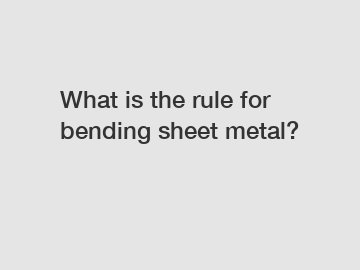What is the rule for bending sheet metal?
What is the Rule for Bending Sheet Metal?
Sheet metal bending is a common practice that has been used for centuries to shape and form metal parts for various applications. It involves using force to bend and stretch the metal, resulting in a desired shape or angle. However, bending sheet metal requires adherence to specific rules and guidelines to ensure successful outcomes. In this article, we will explore the essential rule for bending sheet metal and discuss important considerations to keep in mind during the process.
Understanding the Basics of Bending Sheet Metal.

Before delving into the rules, it is important to have a basic understanding of sheet metal bending. Sheet metal is typically a thin and flat material made from metals such as steel, aluminum, or copper. It comes in various gauges, with lower gauge numbers indicating thicker sheets.
Bending of sheet metal is accomplished by applying force to one side of the metal, while keeping the opposite side anchored. When this force is applied, the metal deforms and takes on a new shape or angle. This process can be performed manually using tools like a brake press, or through automated methods using machines such as a CNC press brake.
The Rule for Bending Sheet Metal: The Bend Allowance.
The most important rule for bending sheet metal is understanding and determining the bend allowance. The bend allowance refers to the amount of material that will be displaced or stretched during the bending process. It is crucial to accurately calculate and account for the bend allowance to ensure precise bending results.
The bend allowance depends on various factors, including the material type, thickness, and angle of the desired bend. It can be calculated using mathematical formulas or determined using bend allowance charts provided by material suppliers or industry standards.
Considerations for Successful Sheet Metal Bending.
In addition to understanding the bend allowance, there are several other considerations to keep in mind when bending sheet metal:
1. Material Selection: Different metals have different properties, including ductility and elasticity. Choosing the right material for your specific application is essential to achieve successful bends without material failure.
2. Tool Selection: The choice of tools, such as press brakes or hand tools, depends on factors like the thickness and complexity of the bend. Selecting the appropriate tooling will ensure accurate and consistent results.
3. Bend Radius: The bend radius refers to the inside radius of the bend. It is important to determine the appropriate bend radius to avoid cracking or distortion of the metal.
4. Springback: Springback is the tendency of the metal to return to its original shape after bending. It is crucial to account for springback when calculating the bend allowance and forming the desired shape.
Closing Thoughts.
Bending sheet metal is a complex process that requires adherence to specific rules and considerations to achieve desired results. Understanding the bend allowance, selecting the right materials and tools, considering bend radius, and accounting for springback are all crucial factors in successful sheet metal bending.
If you have any further questions or need assistance with your sheet metal bending needs, please do not hesitate to contact us. Our team of experts is equipped with the knowledge and experience to provide you with the guidance and support required for your specific projects.
Contact us to discuss your requirements of panel bending, panel bending machine, panel bending. Our experienced sales team can help you identify the options that best suit your needs.


